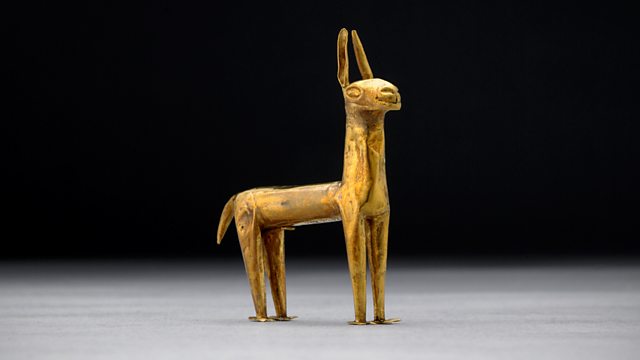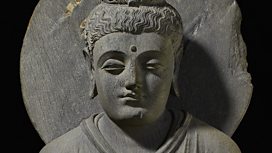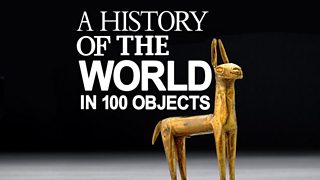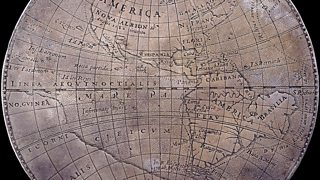Inca gold llama
Neil MacGregor looks at powerful empires across the world 600 years ago - today he is with the great Inca Empire that once dominated South America - and a gold llama.
The history of humanity - as told through one hundred objects from the British Museum in London - is back in South America. This week Neil MacGregor, the museum's director, is with the powerful elites - exploring the great empires across the world 600 years ago. Today he is with a small gold model of a llama, the animal that helped fuel the success of the great Inca Empire that ruled over some 12 million people right down the Pacific West Coast. For a culture living at high altitude in rough terrain and without horses or pack animals, the llama proved all important - for wool, for meat and for sacrifice. Neil tells the story of the Inca, the ways in which they organised themselves and things that they believed in. And he recounts what happened when the Spanish arrived. The scientist and writer Jared Diamond and the archaeologist Gabriel Ramon help tell the story.
Producer: Anthony Denselow
Last on
![]()
Discover more programmes from A History of the World in 100 Objects about religion
About this object
Location: Peru
Culture: Incas and South America
Period: 1400-1550
Material: Gold
��
This small gold model of a llama is a fitting offering for an Inca mountain god. The Incas revered gold as the sweat of the sun and believed that it represented the sun's regenerative powers. All gold belonged to the ruler of the empire, the Inca himself, who claimed to be descended from the sun god. Llamas were the Incas' most important domestic animal, providing food, clothing and acting as beasts of burden. They were also often sacrificed in large numbers to the gods.
Who were the Incas?
The Inca Empire stretched over 5,500 kilometres and was the largest state in the world in the 1400s. Around 40,000 Inca nobles ruled an empire of 12 million conquered people throughout the Andes mountain range in South America. The Incas diverted rivers and used sophisticated irrigation systems to transform mountainsides into lush, terraced fields. Subject people were required to provide soldiers and labourers to work on farms and in mines. Spanish forces arrived in the Andes in the 1530s and finally conquered the Incas after a 40-year struggle.
Did you know?
- The Incas had no cows, sheep, pigs, chickens or goats. Their only domesticated animals were llamas, alpacas and guinea pigs.
The Romans of South America
By Gabriel Ramón, archaeologist
��
��
I will compare the Incas to the Romans. I can say that the Incas were the South American Romans. The word Inca means two things. First, it’s the Empire, we know the Inca Empire. But second, we need to make a difference because Incas were the rulers, not everyone. So sometimes there is a mixture of meanings, if you want. So this Empire was at its peak in the fifteenth and the early sixteenth century.
You know, when the Spanish people arrived they were at their peak, but at the same time there was a problem between groups. One was Atahualpa’s group, and the other was Huascar’s. So there was an internal civil war, if you want. And the empire went from Chile - from the North of Chile and Argentina, to the North of Ecuador. So I think the Spaniards also used the internal disruption to gain more people for their own cause. But they were impressed – the thing that impressed the most the Spanish people were the Inca roads. And Cieza de Leon, a Spanish writer of that period, he said that there was nothing comparable with the Inca road system. And if you see the extension of the Inca Empire, if you compare them in the map with the Aztecs, it’s like four of five times more than the other big empire in the Americas.
You can measure the importance of the Inca in several levels. The main reason is school education. We learn in school that the Incas were the best. So they are in high – they are the peak of Peruvian history, the moment when we did the best. There are several problems with that because Peru is one thing now. The Inca are not necessarily Peru. They use the same territory, but I don’t necessarily feel that there is a connection with all Peruvians. But, returning to education, I would say that when you’re studying at school you know that we lost with Chile in the nineteenth century, so that’s like a sad moment. We lost a war – not only a football match, but a war. So you need to find a moment when we were great, like the peak of empire, so we always remember the Incas.
There is another feature; when the archaeology starts, all these sites in the landscape were defined as Inca because people didn’t know that there were people before. The Incas are the group of people that we know existed because of historical localness. There are a few references of other groups, but we knew that the Incas exist as an empire. So, it’s like a projection, and they were saying all the archaeological sites in the landscape were the Incas. So in a way we multiply the meaning of the Incas. In the school they always say we need to learn the 14 Incas one by one, and we need to know that they were great.
From the school, it goes to politics, because they are politically very useful. So I think that’s the best way to explain why they are important, because they are actually important now.
Fuel, food and ritual
By Gabriel Ramón, archaeologist
��
Of the four Andean camelids (llama, alpaca, guanaco, vicuña) the llama was the most popular in indigenous rituals, beliefs and narratives both before and after the Spanish invasion. This is most likely related to three features. First, the llama is the only camelid useful as a beast of burden. Second, the llama has a wider geographic range than the others; llamas are not limited to the higher parts of the cordilleras, but were also raised at lower elevations, and on the coast. Third, besides its wool (also provided by the other camelids) the llama was a source of edible meat, and even its manure served as fuel. As a consequence, it is not surprising that one of the most recognized constellations in the Andes is the llama, known as Yacana, considered the source of energy for those animals.
During the Inca Empire the ritual killing of this animal was an important part of the major official celebrations. The golden llama figure here presented dates from the Inca Empire, and was probably part of a burial.
During the last five centuries several functions of the llama, and the other Andean camelids, have been replaced by animals of Old World origin, like the cow for meat, and the donkey for transport. However, llamas continued to be widely used for long-distance trips in the Andes for most of the twentieth century.
Nowadays, the expansion of the road system and motorized transport has severely limited this function. However, it is interesting to note that this animal has become a symbol of Peruvian identity. This is clearly related with the European regard to the Andes, since many plates of nineteenth century publications include llamas to indicate that the action was placed in the higher areas of South America.
The national coat of arms, from the 1820s, includes a vicuña. Nowadays, llama meat is rarely consumed in the big cities, nor its manure used as fuel, however several national brands, like matches, include a painting of this animal.
The animal that made it possible
By Jared Diamond, scientist and author
��
We can thank the llama for its contribution to making big empires possible in the Andes.
The domestication of the llama was important for the development of Andean civilisations in several ways: it’s a transport animal, its big enough to carry packs and so it permitted horizontal integration of human societies in the Andes, it permitted transport, eventually from Chile up to Ecuador in stages. The llama also permitted vertical integration. It’s striking that Andean civilisations developed both in the highlands and in the lowlands and they got connected into unified empires.
It was the llama that made it possible to take fish from the ocean and carry them up to emperors in the highlands, and to take products to the highlands and bring them down to the lowlands. The llama also was an animal big enough for meat production and its manure that dropped on the fields would increase the production of crops such as potatoes and other Andean crops. And for all these reasons then state governments and empires, big political units, rose surprisingly early in the Andes, already before the time of Christ and the Andes ended up with the largest empire in the Americas, the largest native American state of the Americas. Namely, the Inca Empire which ran all the way from Equador into northern Chile. You can thank the llama for contributing to making that possible.
Transcript
Broadcasts
- Wed 15 Sep 2010 09:45�鶹������ҳ��� Radio 4 FM
- Wed 15 Sep 2010 19:45�鶹������ҳ��� Radio 4
- Thu 16 Sep 2010 00:30�鶹������ҳ��� Radio 4
- Wed 11 Aug 2021 13:45�鶹������ҳ��� Radio 4
Featured in...
![]()
Religion—A History of the World in 100 Objects
A History of the World in 100 Objects - objects related to religion.
Podcast
-
![]()
A History of the World in 100 Objects
Director of the British Museum, Neil MacGregor, retells humanity's history through objects





